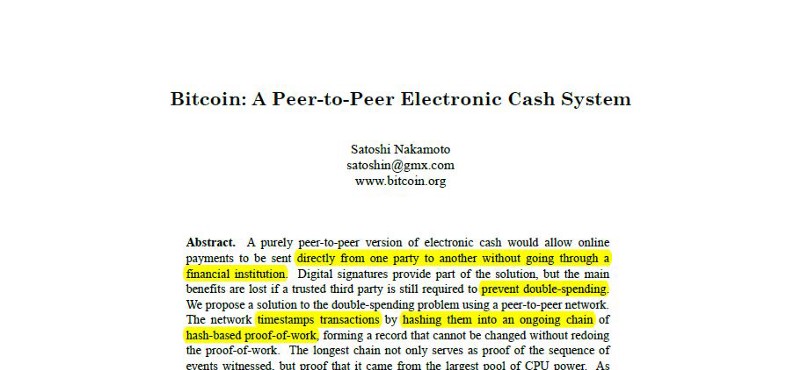October 31st, 2008 – A man by the name of Satoshi Nakamoto published a paper titled “Bitcoin: A Peer-to-Peer Electronic Cash System.” And with that, cryptocurrency was born. The paper proposed a system of digital cash that would be able to function without the need for a central authority, like a bank or government.
And while Nakamoto’s true identity has never been revealed, we do know that they had a profound impact on the world as we know it.
In this blog post, we will be exploring the history of the Bitcoin whitepaper and all the things you need to know about it. From its humble beginnings to its current state, sit back and enjoy a (brief) history lesson on one of the most game-changing inventions of our generation.
The original Bitcoin Whitepaper
In 2008, Satoshi Nakamoto released the Bitcoin whitepaper, which outlined a decentralized digital cash system that could be used to exchange value without the need for a third party. The paper proposed a peer-to-peer network that would use cryptography to allow users to send and receive payments.

Since its release, the Bitcoin whitepaper has been widely influential in the cryptocurrency space. In particular, it has served as the foundation for many of the protocols and technologies that power today’s blockchain networks.
Despite its importance, the identity of Satoshi Nakamoto remains a mystery to this day. Some believe that Nakamoto is a pseudonym for a team of developers, while others believe that he is a single individual. Regardless of who Satoshi is, his work has had a profound impact on the development of cryptocurrencies and blockchain technology.
What has changed since the original Bitcoin Whitepaper?
It has been 14 years since the release of the original Bitcoin whitepaper, and a lot has changed in the cryptocurrency world since then. For one, the total market capitalization of all cryptocurrencies has grown from around $10 billion to over $1.2T. The price of Bitcoin has also risen significantly, from around $1,000 per BTC in 2017 to over $20,538.36 per BTC today.
In addition, there have been numerous improvements to the Bitcoin protocol over the years. These include features such as Segregated Witness (SegWit), which reduces the size of transactions and improves scalability; Lightning Network, which enables near-instantaneous and scalable off-chain payments; and Atomic Swaps, which allows for trustless cross-chain trading.
There have also been many new applications built on top of Bitcoin that make use of its unique properties. These include decentralized exchanges (DEXes), non-custodial wallets, and privacy-focused cryptocurrencies like Monero and Zcash.
The current state of Bitcoin
Bitcoin is a decentralized digital currency, without a central bank or single administrator, that can be sent from user to user on the peer-to-peer bitcoin network without the need for intermediaries. Transactions are verified by network nodes through cryptography and recorded in a publicly distributed ledger called a blockchain. Bitcoin was invented by an unknown person or group of people under the name Satoshi Nakamoto and released as open-source software in 2009.
Bitcoins are created as a reward for a process known as mining. They can be exchanged for other currencies, products, and services. As of February 2015, over 100,000 merchants and vendors accepted bitcoin as payment.
The Past and Future
On this day in 2008, Satoshi Nakamoto released a nine-page document that began a financial revolution and birthed a trillion-dollar industry. A couple of months after the release, the Bitcoin network was launched, with the first block mined on January 3, 2009. About eight days later, Hal Finney received the first transaction of 10 BTC from Nakamoto, after which he posted a legendary tweet that read:
In Satoshi Nakamoto’s Bitcoin whitepaper, he proposed a decentralized electronic cash system that would allow online payments to be sent directly from one party to another without the need for a third party. This would be possible by using a peer-to-peer network to track and verify transactions. Nakamoto also proposed that the system would be secure by using cryptography to ensure that only the sender and receiver of a transaction could view its details.
Since its release, the Bitcoin whitepaper has been widely credited as being instrumental in the development of the cryptocurrency industry. In the years since its release, numerous other cryptocurrencies have been created and released. While some of these have failed to gain traction, others have gone on to become extremely successful.
About a year after the launch of Bitcoin, the cryptocurrency went on to record its first real-world commercial use case when a Florida man spent 10,000 BTC to purchase two large Papa John’s pizzas on May 22, 2010.
Although the coins were worth $41 at prices back then, at today’s price, the transaction is worth more than $200 million. To commemorate the event, the Bitcoin community celebrates Bitcoin Pizza Day every year on May 22.
Conclusion
The Bitcoin whitepaper is a document that laid out the original vision for the cryptocurrency. It has been widely influential in the development of digital currency, and its ideas have been adopted by many other projects.
At the time of writing, cryptocurrencies have a total market capitalization of over $1 trillion. Bitcoin currently makes up roughly 40% of the market share and reached a peak price in November 2018, when it was trading at nearly $70,000 per coin.
Bitcoin has attracted a lot of countries and financial institutions in the past years. It was given legal tender status in El Salvador, its first country to legalize cryptocurrency as a medium of exchange. Bitcoin is also listed in the Guinness World Record as the world’s first decentralized cryptocurrency.
In just 14 years, Bitcoin has accomplished a great deal more than most people think. Despite the current downturn in the market, we should see updates stemming from the creation of Bitcoin over the next 14 years.
If you’re interested in learning more about the history of Bitcoin, or if you’re curious about how it all works, be sure to check out the whitepaper.




